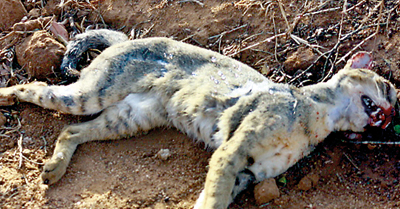News
Big or small, no animal is spared on Yala ‘killer-road’
The ‘Road of Death’ running through the Yala National Park has claimed yet another victim – this time a baby elephant. Many have been the ‘road kills’ in this National Park including a bear and a pregnant she-leopard, by speeding vehicles along the Sella Kataragama-Buttala Road and environmentalists are insistent in their calls for action to safeguard these voiceless victims.

Urgent discussions are underway between the Department of Wildlife Conservation (DWC) and the Road Development Authority (RDA) to impose a speed limit of 50km per hour, assured DWC’s Director of Operations, W.F.K. Pathiratne when contacted by the Sunday Times.
The only answer is to control the speed, he said, explaining that the discussions include the issuance of a Gazette notification by the RDA imposing the speed limit, after which boards would be put up informing drivers about it.
Pointing out that only the “big animal” deaths are being talked about, many environmentalists explained that numerous were the “small creatures” such as civets, jungle cats, mongoose, birds including peafowl, reptiles and frogs crushed to a pulp on this road.
No one knows how many animals are being killed on this road. There is no data. The Yala National Park is under the DWC and although it is a public road, the DWC should take immediate measures to prevent these accidents, was the view echoed by all environmentalists, with the Vice President of the Wildlife and Nature Protection Society, Lal Anthonis, creating the image of large vehicles going at high speed, with the hapless animals not standing a chance of survival on being hit by them.

“Speed limits and speed bumps are the only measures that will protect the animals,” he said.
Environmental lawyer Jagath Gunawardena pointed out that under the Fauna and Flora Protection Ordinance, the DWC can limit the speed on this public road within the Yala National Park, create speed bumps or even prohibit the use of the road in the night.
Without learning a lesson from the fiasco that is this road at Yala and the danger faced by a large number of animals, he said that a foolish decision is being implemented right now to tar a 17km-stretch of road within the Maduru Oya National Park.
The apparent excuse being given is that it is to facilitate visitors, but regrettably it will be at the cost of the wildlife itself, he said, adding that there would be a mad scramble by a large number of vehicles if there is news that a leopard has been spotted and with a tarred road speed limits within the park would be thrown to the winds.
“Many animals will be victims of hit-and-run accidents, for there are no Traffic Policemen within the Maduru Oya National Park,” he said, with barely concealed sarcasm.
Then there will be double tragedy – animals killed on the road at Yala and more animals killed on the tarred road at Maduru Oya, the Sunday Times understands.
What is happening is that speeding motorists go into the territory of wild animals and kill them off. The DWC should act and act immediately, is the call of environmentalists.

Follow @timesonlinelk
comments powered by Disqus






















